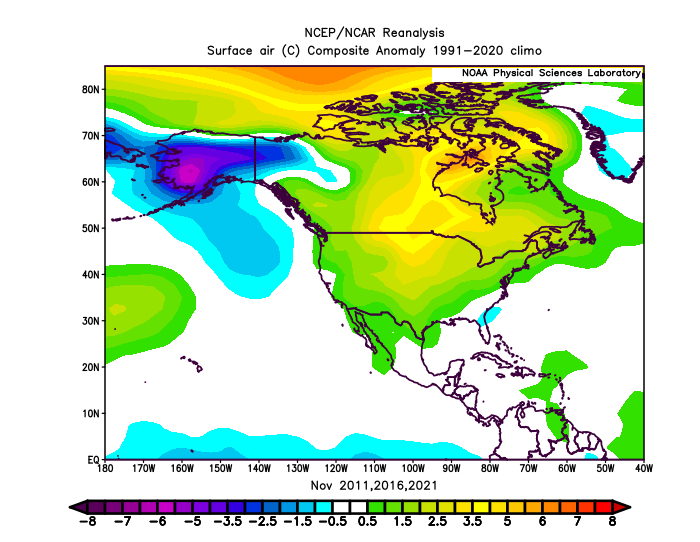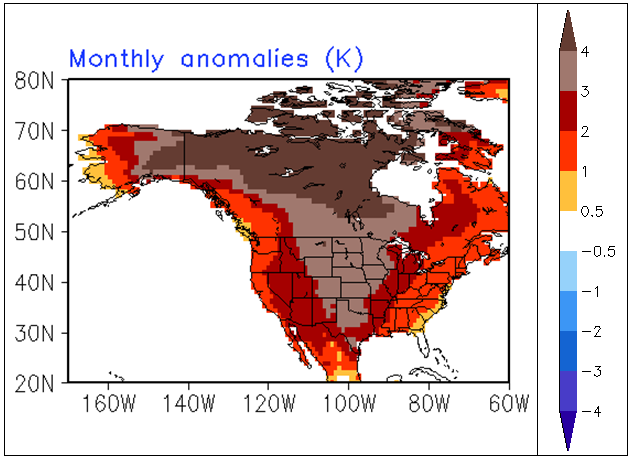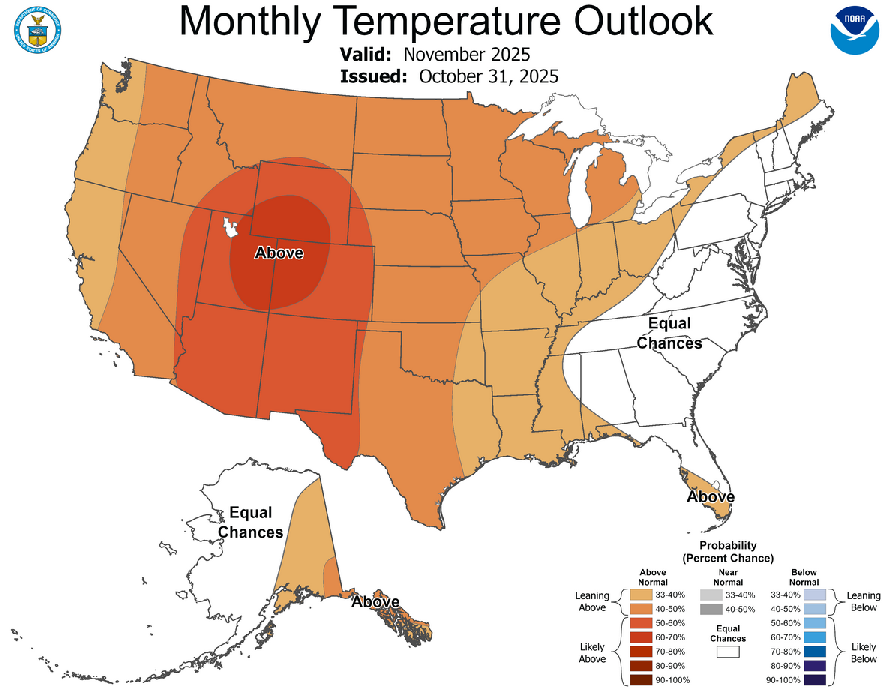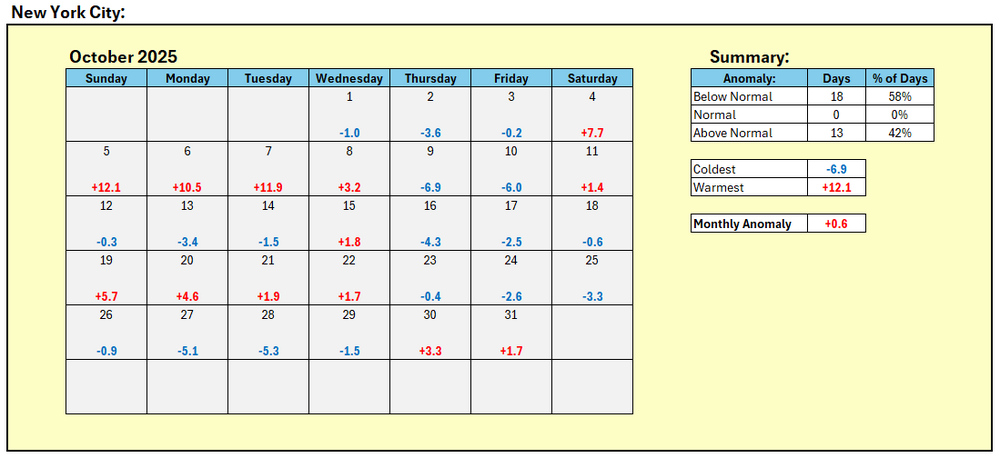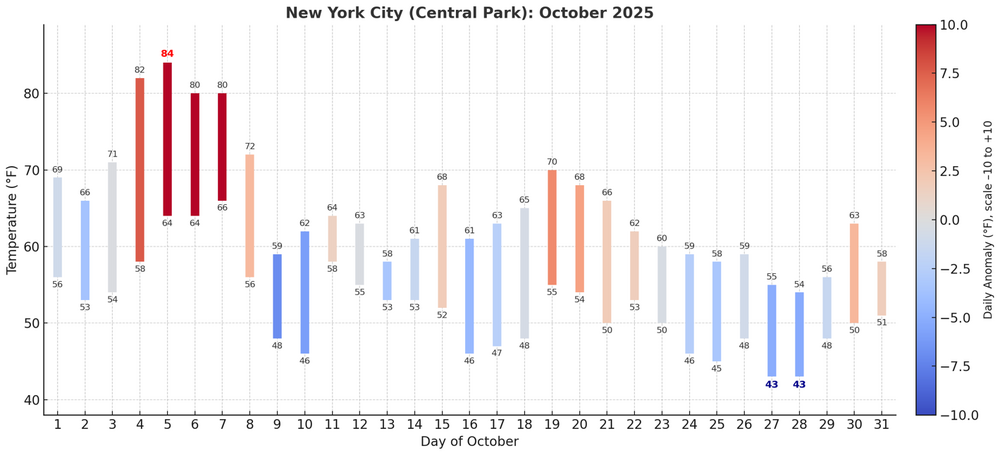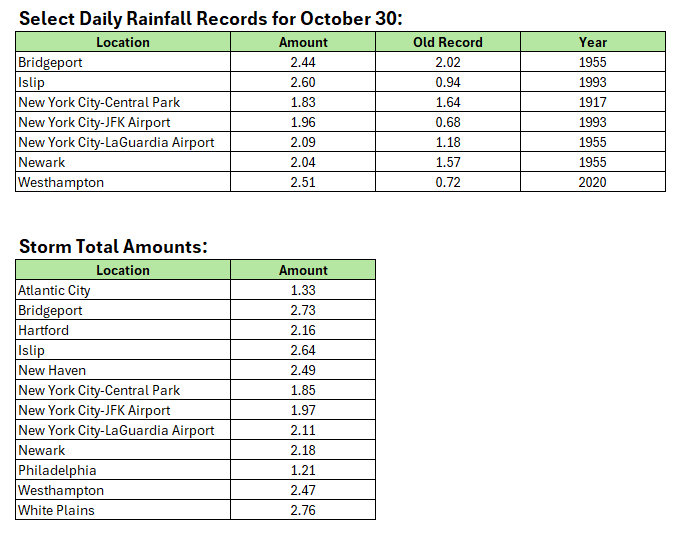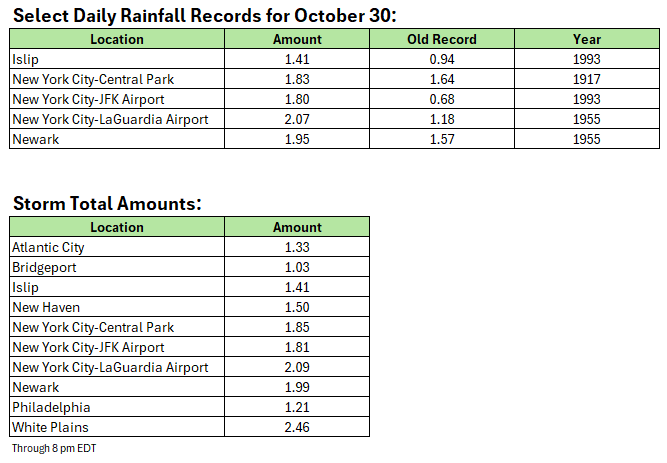-
Posts
22,929 -
Joined
Content Type
Profiles
Blogs
Forums
American Weather
Media Demo
Store
Gallery
Everything posted by donsutherland1
-
Highs will reach the middle and upper 50s in much of the region tomorrow. It will then turn slightly milder with highs in the upper 50s and lower 60s through the middle of next week. A weak cold front could cross the region after midweek, perhaps touching off a few scattered showers. Highs will then fall back to the lower and middle 50s. In the long-range, the guidance suggests that an AO+/NAO+ regime could develop during the first week of the month. As has often happened with the loss of strong blocking, a milder regime could develop shortly afterward. The ENSO Region 1+2 anomaly was +0.3°C and the Region 3.4 anomaly was -0.6°C for the week centered around October 22. For the past six weeks, the ENSO Region 1+2 anomaly has averaged -0.07°C and the ENSO Region 3.4 anomaly has averaged -0.48°C. La Niña conditions will likely continue through mid-winter. The SOI was +5.79 today. The preliminary Arctic Oscillation (AO) was -0.149 today. The NAO was -1.008.
-

2025-2026 ENSO
donsutherland1 replied to 40/70 Benchmark's topic in Weather Forecasting and Discussion
With a generally quiet subtropical jet, I suspect that any large snowstorms are more likely to be of the Miller B variety. Those typically favor the northern Mid-Atlantic/New England or New England. -

2025-2026 ENSO
donsutherland1 replied to 40/70 Benchmark's topic in Weather Forecasting and Discussion
Thanks. I fixed the typo. I am currently thinking NYC will see 15”-25” snowfall during 2025-2026. Of the 53 seasons with such snowfall, 16 (30.2%) had at least one 2-day figure of 10” or more. The most recent was 11.4”, February 8-9, 2013). The figure for all other seasons is 40.0%, meaning that it might be somewhat but not much more challenging to see such a snowfall this winter. Of course, that assumes my current thinking is accurate. -

2025-2026 ENSO
donsutherland1 replied to 40/70 Benchmark's topic in Weather Forecasting and Discussion
If a AO-/NAO-/PNA+ pattern develops, it would have a higher frequency of snowfall in the New York City area and Northeast. Right now, the EPS shows the AO and NAO going negative toward November 25. The PNA remains neutral. But at this range, there's little skill. So, here are the numbers for New York City for November 25-December 10. Add an EPO-, and the respective percentages are 5.6%, 4.5%, 2.2% (89 cases) with all other cases being 3.2%, 1.4%, and 0.5% respectively (631 cases). The EPS shows an EPO-. It should also be noted that numerous La Niña winters have gotten off to a fast start in terms of snowfall. Separately, there's a race in time between what might be a potentially favorable snowfall pattern and a dismal snowfall statistic for New York City. Through October 31, New York City has gone 1,371 consecutive days without a 4" or above daily snowfall. The same applies for a 5" or above daily snowfall. The futility record for both cases is 1,394 consecutive days (February 22, 1929 - December 16, 1932). The futility record could be tied on November 23 and broken on November 24. -

2025-2026 ENSO
donsutherland1 replied to 40/70 Benchmark's topic in Weather Forecasting and Discussion
It's something I'm watching. Some La Niñas have focused the coldest anomalies in the vicinity of the Great Lakes Region. Perhaps this will be the case. I'm hoping to see the ECMWF move in that direction when its new forecasts come out in a few days. -

2025-2026 ENSO
donsutherland1 replied to 40/70 Benchmark's topic in Weather Forecasting and Discussion
This is an experiment. I personally don't like 2011-12 and won't be using it in my winter outlook to be posted in mid-November. 2021-2022 is the only one from that set that will be used in my thinking. I'm just testing an experimental approach aimed at statistically generating analog cases with no human input to see how it does. -

2025-2026 ENSO
donsutherland1 replied to 40/70 Benchmark's topic in Weather Forecasting and Discussion
The December CANSIPS idea seems good to me. It’s also something one should expect with La Niña. -

2025-2026 ENSO
donsutherland1 replied to 40/70 Benchmark's topic in Weather Forecasting and Discussion
Continuing the test of the experimental objective analogs, here's the composite temperature idea for November: For comparison, below are the CFSv2 and CPC forecasts. CFSv2: CPC: -
-
November is on track to finish with a mean temperature of 58.4° in New York City. That is 0.5° above normal and 1.5° above the earlier 1981-2010 baseline. Highs will reach the middle 50s in much of the region tomorrow and Sunday. Lows will mainly be in the lower and middle 40s in New York City and 30s outside the City. In the long-range, the guidance suggests that an AO+/NAO+ regime could develop the first week in November. As has often happened with the loss of strong blocking, a milder regime could develop late in the first week of November or shortly afterward. The ENSO Region 1+2 anomaly was +0.3°C and the Region 3.4 anomaly was -0.6°C for the week centered around October 22. For the past six weeks, the ENSO Region 1+2 anomaly has averaged -0.07°C and the ENSO Region 3.4 anomaly has averaged -0.48°C. La Niña conditions will likely continue through mid-winter. The SOI was +11.28 today. The preliminary Arctic Oscillation (AO) was -1.064 today. The NAO was -1.321.
-

Event Discussion-OBS uncertain tracking thread for possible moderate impact event 8A Thu-8A Fri 10/30-31. Mainly 1-3" rains, G 45-55 MPH-mainly coast, and high prob of at least minor coastal flooding - Thursday afternoon high tide cycle.
donsutherland1 replied to wdrag's topic in New York City Metro
- 246 replies
-
- heavy rain
- damaging wind? squalls?
-
(and 2 more)
Tagged with:
-

Event Discussion-OBS uncertain tracking thread for possible moderate impact event 8A Thu-8A Fri 10/30-31. Mainly 1-3" rains, G 45-55 MPH-mainly coast, and high prob of at least minor coastal flooding - Thursday afternoon high tide cycle.
donsutherland1 replied to wdrag's topic in New York City Metro
- 246 replies
-
- heavy rain
- damaging wind? squalls?
-
(and 2 more)
Tagged with:
-

Event Discussion-OBS uncertain tracking thread for possible moderate impact event 8A Thu-8A Fri 10/30-31. Mainly 1-3" rains, G 45-55 MPH-mainly coast, and high prob of at least minor coastal flooding - Thursday afternoon high tide cycle.
donsutherland1 replied to wdrag's topic in New York City Metro
- 246 replies
-
- heavy rain
- damaging wind? squalls?
-
(and 2 more)
Tagged with:
-

Event Discussion-OBS uncertain tracking thread for possible moderate impact event 8A Thu-8A Fri 10/30-31. Mainly 1-3" rains, G 45-55 MPH-mainly coast, and high prob of at least minor coastal flooding - Thursday afternoon high tide cycle.
donsutherland1 replied to wdrag's topic in New York City Metro
So far, the guidance signaling a significant rain event from the extended range seems to have fared very well. A general 1"-3" has been recorded over a large part of the region, with some locally higher amounts.- 246 replies
-
- heavy rain
- damaging wind? squalls?
-
(and 2 more)
Tagged with:
-
The storm is on track to deliver an expected total 1"-3" rainfall across the region into early tomorrow. A number of locations have seen peak rainfall rates in excess of 1" per hour including: JFK Airport: 1.07" LaGuardia Airport: 1.04" White Plains: 1.18" The system will be followed by a continuation of cool weather. Highs will reach the middle 50s in much of the region tomorrow through Sunday. Lows will mainly be in the lower and middle 40s in New York City and 30s outside the City. In the long-range, the guidance suggests that an AO+/NAO+ regime could develop the first week in November. As has often happened with the loss of strong blocking, a milder regime could develop late in the first week of November or shortly afterward. The ENSO Region 1+2 anomaly was +0.3°C and the Region 3.4 anomaly was -0.6°C for the week centered around October 22. For the past six weeks, the ENSO Region 1+2 anomaly has averaged -0.07°C and the ENSO Region 3.4 anomaly has averaged -0.48°C. La Niña conditions will likely continue through mid-winter. The SOI was +8.51 today. The preliminary Arctic Oscillation (AO) was -0.924 today. The NAO was -1.404. Based on sensitivity analysis applied to the latest guidance, there is an implied near 100% probability that New York City will have a warmer than normal October (1991-2020 normal). October will likely finish with a mean temperature near 58.3° (0.4° above normal). Supplemental Information: The projected mean would be 1.4° above the 1981-2010 normal monthly value.
-

Event Discussion-OBS uncertain tracking thread for possible moderate impact event 8A Thu-8A Fri 10/30-31. Mainly 1-3" rains, G 45-55 MPH-mainly coast, and high prob of at least minor coastal flooding - Thursday afternoon high tide cycle.
donsutherland1 replied to wdrag's topic in New York City Metro
As of 4 pm, New York City has seen 1.81" of rain. That breaks the daily record of 1.64" that was set in 1917. The hourly figure from 3 pm - 4 pm of 0.83" surpassed the hourly record for October 30 that was set during 1955.- 246 replies
-
- 4
-

-

-
- heavy rain
- damaging wind? squalls?
-
(and 2 more)
Tagged with:
-

Event Discussion-OBS uncertain tracking thread for possible moderate impact event 8A Thu-8A Fri 10/30-31. Mainly 1-3" rains, G 45-55 MPH-mainly coast, and high prob of at least minor coastal flooding - Thursday afternoon high tide cycle.
donsutherland1 replied to wdrag's topic in New York City Metro
Through 3:25 pm, Newark has picked up 1.91" of rain today. That breaks the daily record of 1.57" from 1955. Through 3:32 pm, LaGuardia Airport has seen 1.41" of rain. That breaks the daily mark of 1.18" from 1955.- 246 replies
-
- 3
-

-

-
- heavy rain
- damaging wind? squalls?
-
(and 2 more)
Tagged with:
-

2025-2026 ENSO
donsutherland1 replied to 40/70 Benchmark's topic in Weather Forecasting and Discussion
Some Washington, DC winter forecasts: https://wapo.st/3JxBxBT -
A strong NAO blocking regime is in place and will persist into early November. As a result, an extended period of cooler than normal weather will prevail through the end of the month. Tomorrow will be a bit milder as temperatures rise into the upper 50s or lower 60s. Rain will arrive late tonight or early tomorrow. A general 1"-3" rainfall is likely late Wednesday night through Friday. There remains some uncertainty about the area of heaviest rainfall. The storm will be followed by a continuation of cool weather. In the long-range, the guidance suggests that an AO+/NAO+ regime could develop the first week in November. As has often happened with the loss of strong blocking, a milder regime could develop late in the first week of November or shortly afterward. The ENSO Region 1+2 anomaly was +0.3°C and the Region 3.4 anomaly was -0.6°C for the week centered around October 22. For the past six weeks, the ENSO Region 1+2 anomaly has averaged -0.07°C and the ENSO Region 3.4 anomaly has averaged -0.48°C. La Niña conditions will likely continue through mid-winter. The SOI was +18.18 today. The preliminary Arctic Oscillation (AO) was -0.392 today. The NAO was -1.634. Based on sensitivity analysis applied to the latest guidance, there is an implied 85% probability that New York City will have a warmer than normal October (1991-2020 normal). October will likely finish with a mean temperature near 58.3° (0.4° above normal). Supplemental Information: The projected mean would be 1.4° above the 1981-2010 normal monthly value.
-
This is a perennial debate with multiple perspectives and no single solution. For longer-term climate perspectives, 1951-1980 (GISS) or 1901-2000 (NOAA) are good baselines. Those baselines allow one to compare the contemporary climate to a longstanding baseline for purposes of assessing how the climate has changed. The current 30-year figures reflect the current state of the climate, which is warmer than it was when assessed against the longer-term baselines typically used in climate research. The current figures also address the question visitors to locations might ask e.g., "What is it typically like in December in New York City?" That could be important for a visitor from Toronto who wants to know whether she really needs a sweater to view the lighting of the Rockefeller Center Christmas tree. Although the headline monthly anomaly, which will be slightly positive is typically used to define the monthly outcome, a better picture involves getting into more detail. The month will wind up with 58%-61% of days having been cooler than the 1991-2020 baseline. Moreover, the average anomaly was skewed by October 5-7, all of which averaged 10.5° or more above normal. Excluding those days, the monthly anomaly would be reduced by 1.3°. A trimmed mean, which would drop the three coldest and warmest days relative to normal would still result in a mean that would be 0.6° cooler. Here's how October looks through October 28th:
-

Major Hurricane Melissa - 892mb - 185mph Jamaica landfall
donsutherland1 replied to GaWx's topic in Tropical Headquarters
Yes, they have clearance. -
A strong NAO blocking regime is in place and will persist into early November. As a result, an extended period of cooler than normal weather will prevail through the end of the month. Tomorrow will be another cool day. Temperatures will top out in the lower and middle 50s across much of the region. The unseasonably cool weather will continue through at least the middle of the week before it turns a bit milder. Rain will likely arrive Wednesday night or Thursday. A general 1"-3" rainfall is likely late Wednesday night through Friday. There remains uncertainty about the area of heaviest rainfall. The storm will be followed by a continuation of cool weather. The ENSO Region 1+2 anomaly was +0.3°C and the Region 3.4 anomaly was -0.6°C for the week centered around October 22. For the past six weeks, the ENSO Region 1+2 anomaly has averaged -0.07°C and the ENSO Region 3.4 anomaly has averaged -0.48°C. La Niña conditions will likely continue through mid-winter. The SOI was +23.46 today. The preliminary Arctic Oscillation (AO) was +0.455 today. The NAO was -1.744. That is the lowest NAO figure since November 22, 2024 when the NAO was -1.823. Based on sensitivity analysis applied to the latest guidance, there is an implied 78% probability that New York City will have a warmer than normal October (1991-2020 normal). October will likely finish with a mean temperature near 58.3° (0.4° above normal). Supplemental Information: The projected mean would be 1.4° above the 1981-2010 normal monthly value.
-
The preliminary global mean temperature for October 26 was 14.99°C. That would easily surpass the existing mark of 14.93°C from 2024. To date, 329/366 (89.9%) of daily records have been set or tied in 2023, 2024, and 2025. The oldest surviving records were set on December 9-10, 2015. The ERA-5 dataset goes back to 1940.
-
A strong NAO blocking regime is in place and will persist into early November. As a result, an extended period of cooler than normal weather will prevail through the end of the month. Tomorrow will be another cool day. Temperatures will top out in the lower and middle 50s across much of the region. Many locations outside of New York City will again see readings start in the 30s. Hard freezes are again likely well north and west of New York City. The unseasonably cool weather will continue through at least the middle of the week. Rain will likely arrive Wednesday night or Thursday. A general 1"-3" rainfall is likely late Wednesday night through Friday. There remains uncertainty about the area of heaviest rainfall. The storm will be followed by a continuation of cool weather. The ENSO Region 1+2 anomaly was +0.3°C and the Region 3.4 anomaly was -0.6°C for the week centered around October 22. For the past six weeks, the ENSO Region 1+2 anomaly has averaged -0.07°C and the ENSO Region 3.4 anomaly has averaged -0.48°C. La Niña conditions will likely continue through mid-winter. The SOI was +23.33 today. The preliminary Arctic Oscillation (AO) was +1.351 today. The NAO was -1.497. Based on sensitivity analysis applied to the latest guidance, there is an implied 70% probability that New York City will have a warmer than normal October (1991-2020 normal). October will likely finish with a mean temperature near 58.2° (0.3° above normal). Supplemental Information: The projected mean would be 1.3° above the 1981-2010 normal monthly value.




